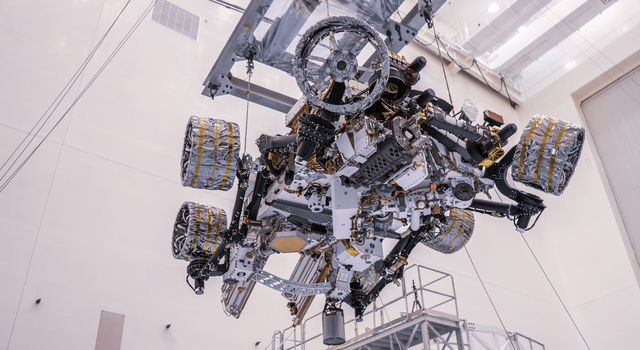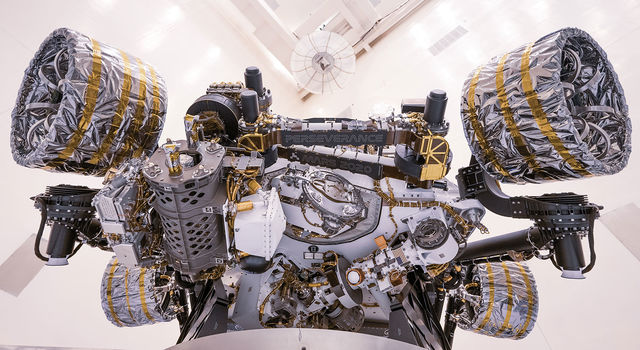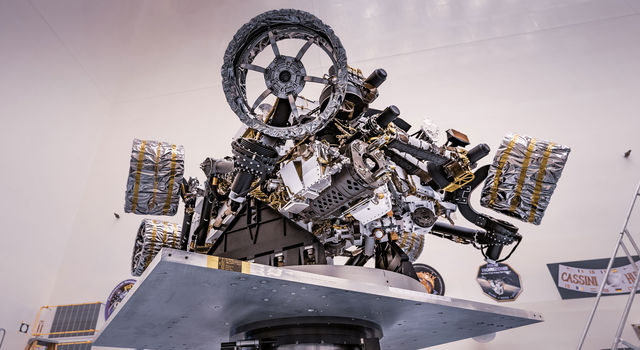Picking up on a suggestion from an Alabama high-school junior, NASA has given an ingenious name to the first helicopter due to take flight on Mars.
- The new name, Ingenuity, was submitted by Vaneeza Rupani of Tuscaloosa County High School in Northport, Ala., for NASA’s “Name the Rover” essay contest. NASA went with a different name for the 2020 Mars rover — Perseverance — but held onto Rupani’s suggestion for the rotor-equipped drone that will be deployed from the rover.
- In her essay, Rupani explained that “ingenuity is what allows people to accomplish amazing things, and it allows us to expand our horizons to the edges of the universe.” In a news release, NASA Administrator Jim Bridenstine said the name “encapsulates the values that our helicopter tech demo will showcase for everyone when it takes off next year as the first aircraft on another planet’s surface.”
- The Perseverance mission is due for launch from Cape Canaveral Air Force Station in Florida in July or August, with the landing on Mars set for next February. After touchdown, the 4-pound, solar-powered Ingenuity helicopter is to be deployed from Perseverance’s belly for a series of brief flights during a monthlong test window.
Quelle: GeekWire
----
Update: 4.05.2020
.
NASA's Perseverance Rover Will Look at Mars Through These 'Eyes'

A close-up of the head of Perseverance Rover's remote sensing mast. The mast head contains the SuperCam instrument (its lens is in the large circular opening). In the gray boxes beneath mast head are the two Mastcam-Z imagers. On the exterior sides of those imagers are the rover's two navigation cameras. Image Credit: NASA/JPL-Caltech

This image shows a 3-D printed model of Mastcam-Z, one of the science cameras on NASA's Perseverance Rover. Mastcam-Z will include a 3:1 zoom lens. Image Credit: NASA/JPL-Caltech

This image presents a selection of the 23 cameras on NASA's Perseverance Rover. Many are improved versions of the cameras on the Curiosity rover, with a few new additions as well. Image Credit: NASA/JPL-Caltech
A pair of zoomable cameras will help scientists and rover drivers with high-resolution color images.
When it launches this summer, NASA's Perseverance rover will have the most advanced pair of "eyes" ever sent to the Red Planet's surface: Its Mastcam-Z instrument packs a next-gen zoom capability that will help the mission make 3D imagery more easily. Rover operators, who carefully plan out each driving route and each movement of a rover's robotic arm, view these stereo images through 3D goggles to see the contours of the landscape.
Located on Perseverance's "head," Mastcam-Z (the Z stands for "zoom") is a more advanced version of Mastcam, which NASA's Curiosity Mars rover has relied on to produce gorgeous panoramas of the Martian landscape. But it does more than that, and so will Mastcam-Z: Along with producing images that enable the public to follow the rover's daily discoveries, the cameras provide key data to help engineers navigate and scientists choose interesting rocks to study. The difference is that Curiosity's Mastcam can't zoom.
Zoom With a View
Curiosity's Mastcam was initially designed to be zoomable, but that proved difficult to achieve at the time in such a small instrument (Curiosity launched in 2011).
"The original plan was for Curiosity to have a zoom camera that could go out to an extreme wide angle like a spaghetti western view," said Jim Bell of Arizona State University, Mastcam-Z's principal investigator and Mastcam's deputy principal investigator. "It would have been an amazing panoramic perspective but proved really hard to build at the time."
Instead, Curiosity's Mastcam has one telephoto lens and one wide-angle lens. Images are taken through each and can be combined to produce stereo views. But the wide-angle lens takes in far more of the landscape in a single shot than the telescopic one; it requires up to nine telescopic images to match.
Perseverance's Mastcam-Z simplifies matters, zooming both lenses until they match and can be used to make a single 3D image. This is both easier and requires sending fewer images - and less data - to Earth.
Eyes of a Scientist
Besides providing a stereo view to help drivers choose the safest path, Mastcam-Z will help geologists choose scientific targets and better understand the landscape that rock samples are found in: Did they fall from a neighboring cliffside? Are they from an ancient stream?
Mastcam-Z will provide "superhuman vision," viewing the landscape in a variety of colors (wavelengths of light), including some that can't be detected by the human eye. Scanning the terrain in the ultraviolet or infrared, for example, could reveal metal meteorites dotting the surface or color variations indicating compositions that warrant more detailed analysis by other instruments.
Mastcam-Z isn't a spectrometer, which is to say, an instrument that uses light to do detailed scientific analysis. "But it can provide mineral clues that other instruments will follow up on," Bell said.
The camera system can also observe the Sun and sky, watching for transits of Mars' moons across the Sun and measuring how dust storms and cloud formations change over the seasons.
Mars for the People
Bell's first experience with Mars pictures was as an 11-year-old, watching images on the nightly TV news sent back by the Viking landers in 1976. He was later involved in the Mars Pathfinder mission and went on to lead the Pancam systems on the Spirit and Opportunity rovers, which inspired a new generation of Mars fanatics, including future scientists and engineers.
The vistas that Perseverance will send back from its landing site, Jezero Crater, will be just as significant for those who work on the mission and everyone who's following along.
That's why there are plans to share Mastcam-Z images and mosaics made by the amateur community on a public website. "It's important that the public have a sense of ownership," Bell said. "The Mastcam-Z images belong to all of us."
Perseverance is a robotic scientist weighing about 2,260 pounds (1,025 kilograms). The rover's astrobiology mission will search for signs of past microbial life. It will characterize the planet's climate and geology, collect samples for future return to Earth, and pave the way for human exploration of the Red Planet. No matter what day Perseverance launches during its July 17-Aug. 5 launch period, it will land at Mars' Jezero Crater on Feb. 18, 2021.
The Mars 2020 Perseverance rover mission is part of a larger program that includes missions to the Moon as a way to prepare for human exploration of the Red Planet. Charged with returning astronauts to the Moon by 2024, NASA will establish a sustained human presence on and around the Moon by 2028 through NASA's Artemis lunar exploration plans.
Quelle: NASA
----
Update: 9.05.2020
.
NASA's Perseverance Rover Spacecraft Put in Launch Configuration

NASA's Mars Perseverance rover's descent stage was recently stacked atop the rover at Kennedy Space Center, and the two were placed in the back shell that will help protect them on their journey to Mars. In this image, taken on April 29, 2020, the underside of the rover is visible, along with the Ingenuity helicopter attached (lower center of the image). The outer ring is the base of the back shell, while the bell-shaped objects covered in red material are covers for engine nozzles on the descent stage. The wheels are covered in a protective material that will be removed before launch.

The cone-shaped back shell for NASA's Perseverance rover mission sits on a support structure in this April 29, 2020, image from Kennedy Space Center in Florida. Along with the heat shield, the back shell provides protection for the rover and descent stage during Martian atmospheric entry. Portions of the descent stage and rover, stacked one on top of the other, can be seen in the open area directly below the lower edge of back shell.









